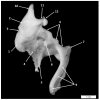Morphological, Histological and Morphometrical Aspects of Auditory Ossicles in Pig Fetuses (Sus scrofa domestica)
- PMID: 40281963
- PMCID: PMC12024052
- DOI: 10.3390/ani15081129
Morphological, Histological and Morphometrical Aspects of Auditory Ossicles in Pig Fetuses (Sus scrofa domestica)
Abstract
The detailed study of the morphology and morphometrics of the auditory ossicles in swine became a topic for investigation due to their resemblance to the human ear. The methods used in this study cover the typical macroscopical investigation of gross morphology: a detailed metrical and histological assessment through H&E standard protocol on auditory ossicles originating from eight pig fetuses originating from four distinctive sows. The ossicular assembly in the malleus, incus and stapes present in 66-day fetuses shows all the features generally described in swine. The malleus comprises two uneven laminae of mineralized hyaline cartilage and a medullary cavity. The areas of the head and neck show a high degree of vascularization. The incus has two similar cortical fascicles separated by a compartmentalized medullary cavity, with the highest degree of mineralization found at the distal part of the long process. Stapes show an early degree of mineralization at the level of the crura, lacking medullary cavities. The ossicular chain shows typical morphological elements, similar to adults, and from a dimensional perspective, our investigations point to an uneven degree of development of the ossicles, according to gestational age: the malleus and stapes reach almost 80% and the incus about 50-60% of their adult sizes.
Keywords: Sus scrofa; fetus; gross anatomy; histology; incus; lever ratio; malleus; morphometry; ossicula auditoria; stapes.
Conflict of interest statement
The authors declare no conflicts of interest.
Figures








Similar articles
-
Morphological and Morphometrical Aspects of the Auditory Ossicles in the European Badger (Meles Meles).Vet Sci. 2022 Sep 8;9(9):483. doi: 10.3390/vetsci9090483. Vet Sci. 2022. PMID: 36136699 Free PMC article.
-
Anatomic and morphometric examination of auditory ossicles in sheep.Anat Histol Embryol. 2024 Jan;53(1):e12998. doi: 10.1111/ahe.12998. Epub 2023 Nov 20. Anat Histol Embryol. 2024. PMID: 37985461
-
Morphological and morphometrical aspects of the auditory ossicles in goat (Capra hircus).Anat Histol Embryol. 2021 Jan;50(1):184-191. doi: 10.1111/ahe.12617. Epub 2020 Sep 18. Anat Histol Embryol. 2021. PMID: 32946143
-
Morphological and Morphometrical Study of the Human Ossicular Chain: A Review of the Literature and a Meta-Analysis of Experience Over 50 Years.J Clin Med Res. 2016 Feb;8(2):76-83. doi: 10.14740/jocmr2369w. Epub 2015 Dec 28. J Clin Med Res. 2016. PMID: 26767074 Free PMC article. Review.
-
Three-dimensional quasi-static displacement of human middle-ear ossicles under static pressure loads: Measurement using a stereo camera system.Hear Res. 2023 Jan;427:108651. doi: 10.1016/j.heares.2022.108651. Epub 2022 Nov 14. Hear Res. 2023. PMID: 36462376 Review.
References
-
- Parodi A.-L., Barone R., Simoes P. Anatomie Comparée Des Mammifères Domestiques, Paris, Vigot Édit., 2010, 7, Neurologie 2, 836 p. Bull. Acad. Natl. Med. 2011;195:1148–1150. doi: 10.1016/s0001-4079(19)32028-x. - DOI
-
- Barone R., Bortolami R. Anatomie Comparee Des Mammiferes Domestiques. Tome Sixieme. Neurologie I. Systeme Nerveux Central. Vigot Frerres; Paris, France: 2004.
Grants and funding
LinkOut - more resources
Full Text Sources

